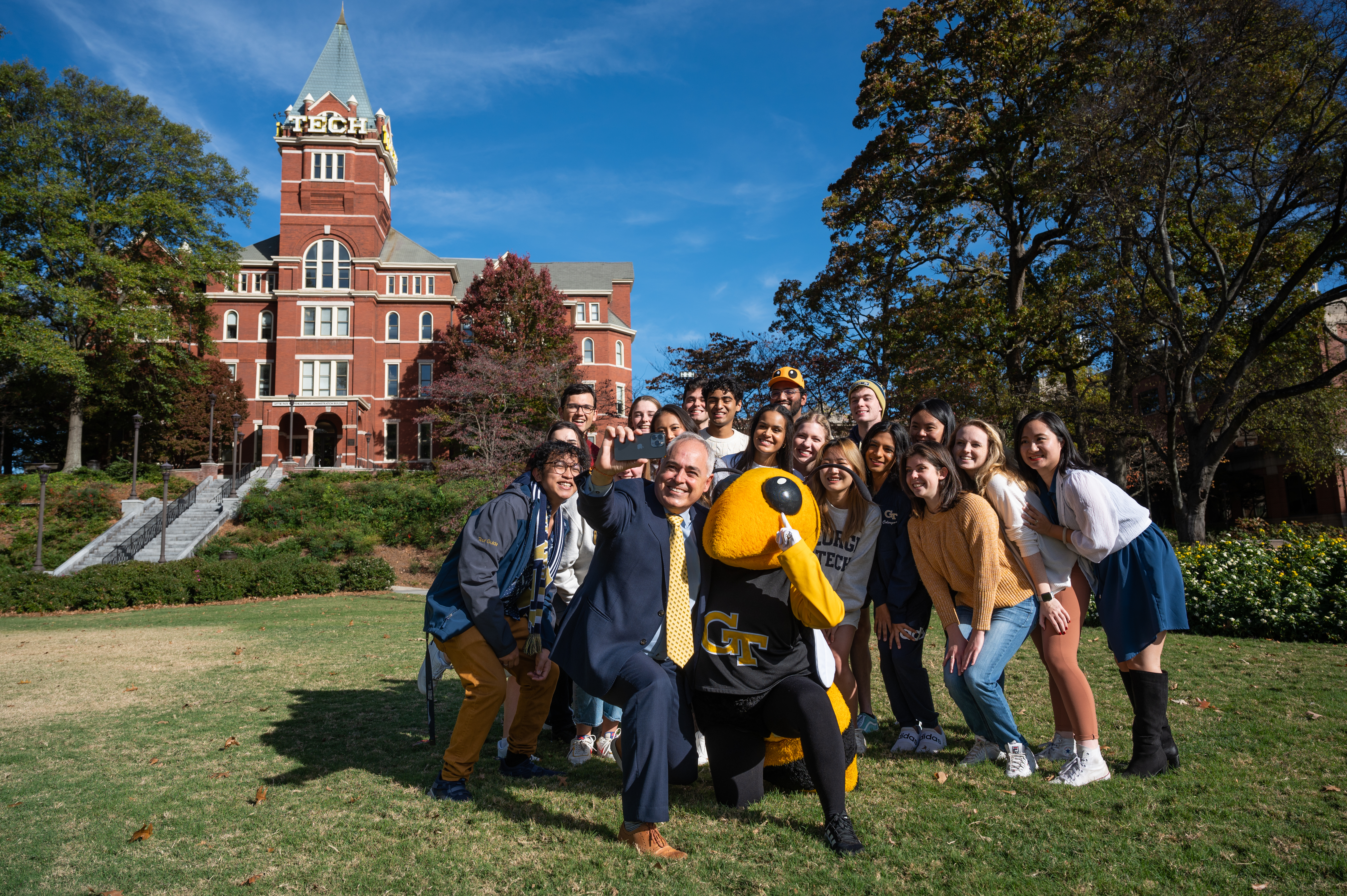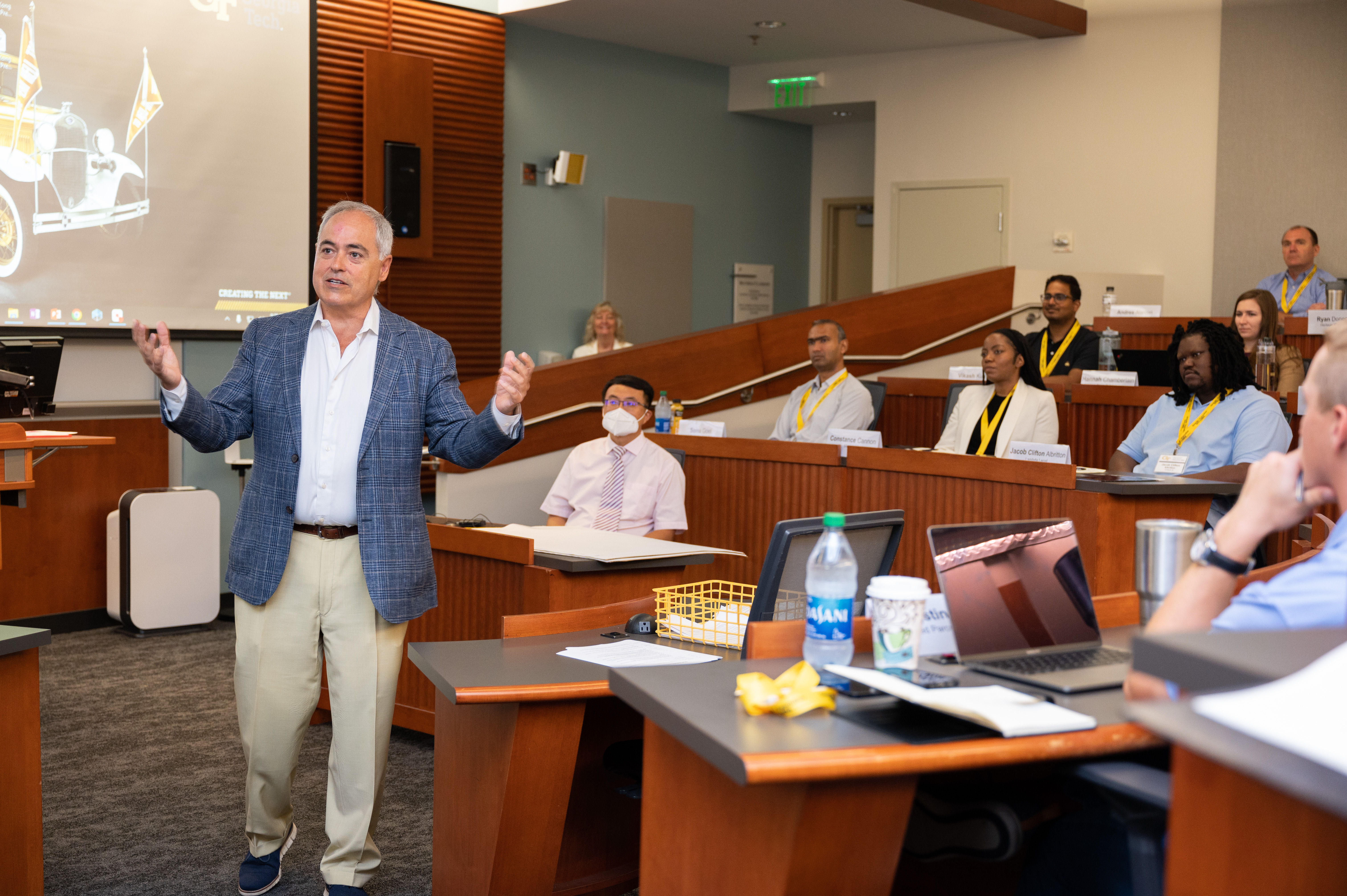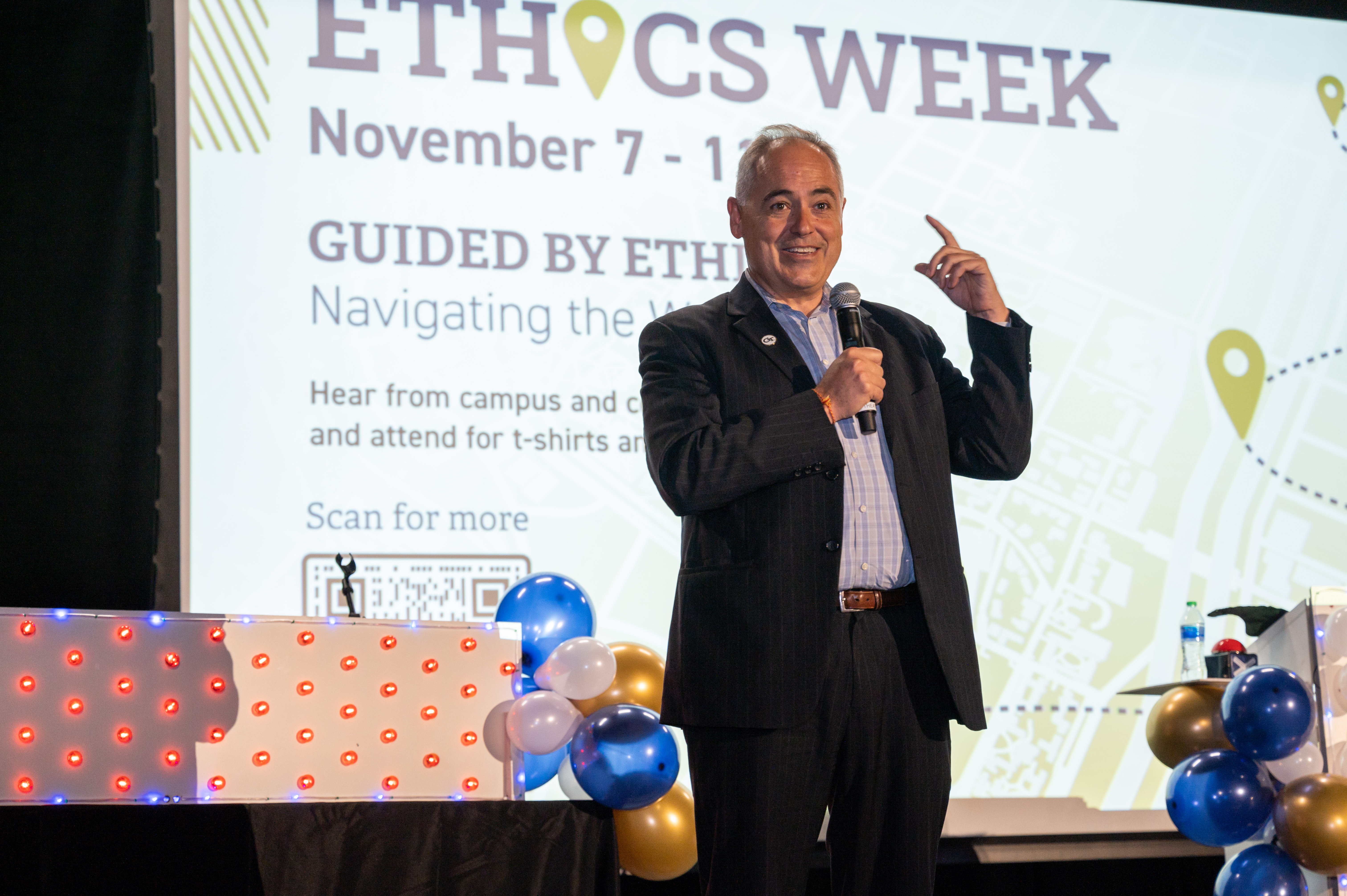With just a few years as president, Dr. Cabrera kept the fastest-growing, research intensive university open through the pandemic increasing its enrollment by 8,800 students.
Dr. Ángel Cabrera was the last generation to remember Spain’s dictator Francisco Franco. Under the dictatorship, his parents couldn’t pursue a college education, but Dr. Cabrera—who lived through Spain’s transition to freedom as a child—was able to do so.
“At home, there was no doubt that my goal was to go to a university. That was always my parents’ perspective,” he said. “I became a first-generation college kid. Then, I went from being a first-generation college kid to getting a doctorate at Georgia Tech [Georgia Institute of Technology]. It was a pretty big leap for our family.”
“My parents didn’t understand what it meant to get a doctorate degree,” said Dr. Cabrera, who had always been interested in the field of education. “But my grandfather had been the only teacher in a small town of Extremadura. Everyone respected him. So, I thought being a teacher would be the most amazing thing anyone can do. I still think that.” Today, Dr. Cabrera has achieved much more than what was possible under Franco’s dictatorship and his family’s history. He is president of Georgia Tech, the very school from which he received his master’s and doctorate in cognitive psychology. “I am an alumnus from here, I married an alumnus, and I am the father of an alumnus,” he said. “This institution changed my life!”
For Dr. Cabrera, education is everything. “When I meet high school kids, I tell them to make school a priority,” he said. “The safest path to a good job, good life, and a good career in the 21st century is a college degree.”

A Binational Trajectory towards Leadership
The president’s own path to success began with receiving a bachelor’s in electrical and computer engineering at Universidad Politécnica de Madrid, Spain’s most competitive engineering school. Then, upon the advice of others, he applied for and received a Fulbright Program scholarship to study in the U.S.
Upon completing his doctorate at Georgia Tech, Dr. Cabrera returned with his new wife to Madrid, Spain, to work as a consultant for Accenture, a multinational management consulting, technology services, and outsourcing company. Here his two children were born, and he ultimately became dean at the IE Business School, a Spanish and European graduate and undergraduate business school.
In 2002, when his children were five and seven, the president and his family decided to return to the U.S. Here he was offered the chance to lead Thunderbird School of Global Management, an institution that is now part of Arizona State University. In 2012, he was appointed president of George Mason University in Virginia, and most recently, in 2019, he took the helm of Georgia Tech.
Although Dr. Cabrera was a “happy camper” at George Mason University, he was honored by the invitation to lead his alma mater. “I have strong ties to Atlanta and Georgia Tech,” he said. “This is also one of those institutions that has the size and caliber of people to be the source of new solutions to problems we face today. A whole bunch of people are doing cutting edge work here.”
Georgia Tech’s engineering and computing colleges were already considered among the largest and highest ranked in the nation when the president took the helm. In addition, its programs, such as business, design, liberal arts, and sciences had thus far garnered a reputation.

Facing the Pandemic
Yet the school’s “cutting edge” reputation, in addition to Dr. Cabrera’s successful leadership style, were soon put to the test after he became president in June of 2019. “We went through the Covid pandemic soon after I arrived,” he said. “It was a challenging time, but I am proud of what we did!”
Under Dr. Cabrera’s leadership, Georgia Tech created its own technology to deal with the pandemic. “We created saliva-based PCR tests and were able to take 3,000 samples a day,” he said. “The key was building an infrastructure from scratch. We also built robotics and automized a process to send 3,000 emails a night to users with their results.”
The president claims that the best thing he did was “to trust my teams and empower my faculty.” “We have a ton of talent at Georgia Tech and so I challenged people to do their part,” he said. “It was about community coming together, being smart, and building an infrastructure. We created a dashboard with the number of cases we had. We were radical in the information we gave out to the community.”
What was unique to Georgia Tech, compared to other institutions around the country, is that it didn’t close during the pandemic. “We did everything we could to stay open,” said Dr. Cabrera. “We were already doing online learning, which was a blessing. We’ve had one of the largest online master’s programs such as data analytics, cyber security, and computer sciences. So, we gave our students that pandemic year in college.”

Increasing Enrollment and Research Funding
Beyond the pandemic, Dr. Cabrera has bucked trends in higher education in other ways. During the time he has been president, the school increased enrollment by 8,800 students, while the nationwide trend has been that of shrinking enrollment.
At first, the president attributed his successes to his school’s strong reputation as a leading technological institution nationwide and Atlanta as an attractive place to live, especially because of new tech companies moving in. Yet, he admitted that he made a conscious effort to increase enrollment upon taking the helm.
“When I came here, we had a record number of applicants, and had many tech companies recruiting from us. But for many years, we weren’t growing,” he said. “I decided we should make more room for students. Especially as a public institution, we have a responsibility to make a difference.”
Dr. Cabrera’s goal to increase enrollment came with clear effort. He created pathway programs from Atlanta Public Schools to Georgia Tech. Those students who couldn’t get in on their first try were invited to take certain courses and, upon doing well in them, were automatically accepted. In addition, the university became more accessible to more students without lowering its standards.
Consequently, Georgia Tech is one of the fastest growing research-intensive universities in the nation. “We broke records for Georgia Tech unheard of in our history,” said Dr. Cabrera. “We have broken records in graduation rates with one of the best 6-year-graduation rates. We are growing and still attracting the best students in the country and graduating them at higher rates. It’s been remarkable!”
According to Dr. Cabrera, during his brief time at Georgia Tech, he has also increased his school’s research award amounts by a quarter of a billion dollars. “We have become a top-tier research institution without having a medical school,” he said. “A third of all federal dollars of research money go to institutions with medical schools. But we are getting research dollars and don’t have a medical school.”
While the president’s success can be attributed to Georgia Tech’s prior reputation, his own reputation also precedes him. During his seven years as president of George Mason University, the school reached the highest research tier in the Carnegie Classification. In addition, GMU enrollment increased by more than 5,000 students.
Today, at Georgia Tech, Dr. Cabrera is responsible for leading a 10-year strategic plan launched in 2020. More than 5,700 members of the school community came up with a plan whose goals include the following: amplifying the school’s impact on society, championing innovation, connecting globally, expanding access, cultivating well-being, and leading by example.
Supporting Hispanic Students
Already, the president has increased access to Georgia Tech, and expanded its impact on society through research opportunities. Also, as the first Latino president at the university, he has led by example. “Hispanic students love that they have a president who speaks Spanish,” he said. “I support them in every way I can.”
While Hispanics only make up 7.9 percent of Georgia Tech, their numbers are over 1,400 out of 18,415 undergraduates (based on 2022 Georgia Tech demographics, Department of Institutional Research and Planning). Hispanics also represent 5.5 of 26,881 graduate students.
“The Hispanic population is small but as a big university, it represents a large and healthy community,” said Dr. Cabrera. “My son went to Georgia Tech and was very active in the Society of Hispanic Professional Engineers. Hispanics are super well organized here. They have a strong presence on campus.”
The president has worked on building pathways with students at Atlanta Public Schools, where Hispanics make up the largest growing minority population. “We do robotics and events and offer research opportunities in schools. We try to target underrepresented students,” he said. “We want students to think about STEM fields, especially girls of all ethnicities.”
Georgia Tech has multiple programs and organizations designed to support Hispanics. Most importantly, however, is Georgia Tech’s Office of Hispanic Initiatives, which was established in 2001 to support the Hispanic and Latino community there in various ways: assisting in recruiting high-achieving, talented students; enriching the educational experience for Hispanic and Latino students by fostering an inclusive and supportive environment; offering programs and events to help Hispanic and Latino students grow academically, personally, and professionally; and preparing Hispanic and Latino students for success after graduation.
Other important campus organizations and programs for Latinos include the Georgia Tech Hispanic Alumni Network, Ecuadorian Student Organization, Georgia Tech Salsa Club, Society of Professional Hispanic Engineers, Office of Undergraduate Admissions Hispanic Recruitment Team, Latin American Student Organization, Latino Organization of Graduate Students, Student Alumni Association, Spanish Speaking Organization, Scheller College Latin America Club, Association of Latino Professionals for America, and Hispanic Heritage Month Celebrations.
In addition, the Goizueta Foundation Scholarships and Fellowships have supported more than 370 Hispanic and Latino students to date (2002-2022). The annual Latino Welcome Celebration also provides incoming and current Hispanic/Latinx students the opportunity to experience the Hispanic atmosphere at Georgia Tech and network with other students, faculty, staff, and corporate representatives.
The benefits of all these programs became evident when Diverse magazine recognized Georgia Tech in its “Producers of Minority Degrees” article. In 2019, it listed the university as #4 in producing master’s and doctoral degrees for Hispanics in computer and information sciences and support services. In addition, Georgia Tech was listed #5 in producing doctorate engineering degrees and #15 in doctoral degrees in physical sciences in the same year.
Understandably, Hispanics and underrepresented students have had a chance to soar at Georgia Tech due to its strong reputation in STEM fields. And now, with Dr. Cabrera at the helm, his example provides even more incentive for Latinos to believe that they too can be successful.
“Having a role model that looks and talks like you is always inspiring and sends a message of what you can be,” said Dr. Cabrera, who, years earlier, was named a “Young Global Leader” by the World Economic Forum.
“I tell Hispanics to be proud of their background and not lose their Spanish,” he added. “When looking for a job, this is what makes us unique. Protect and cultivate that because it’s a huge advantage!”